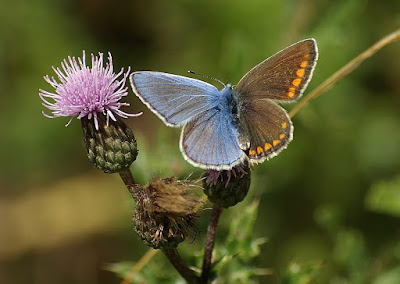Litinsects #59: Gynandromorphs
Ok people, pretty sure I’m
gonna blow your minds with this one. No, these pictures are not some freakish
cut-and-paste Frankenstein experiments. These animals are absolutely real and extremely
rare GYNANDROMORPHS.

Common blue gynandromorph (left male, right female)
© Burkhard Hinnersmann
This word comes from the Greek “gyne” for female, “andro” for male, and “morph” for form... meaning that these individuals contain BOTH MALE AND FEMALE tissues!
Firstly, this is not the same thing as a hermaphrodite, which is an organism that contains both types of gonads or can create both sperm and eggs. Gynandromorphs literally have some body parts that are genetically female and others that are genetically male. So I’m sure you’re asking... how?!

Malaysian stick insect (left male, right female)
https://commons.wikimedia.org/wiki/File:Heteropteryx_dilatata_0034b_L.D.jpg
Many different genetic systems
exist in the animal kingdom. In humans XX codes for female and XY for male* but
other animal groups use different chromosome combinations or different genetic
systems entirely to determine sex (even within insects there is variation). In
general gynandromorphy usually arises when a CELLULAR ERROR occurs very early
in development, while there are only a few cells. If the sex chromosomes
separate incorrectly during cell division of one of these early cells, one resulting
cell may end up with a number or combination of chromosomes genetically coding
for male while the other ends up coding for female. As each of the two cells
continues to divide, they produce genetically distinct cell lineages, resulting
in a CHIMERA, an organism composed of cells with non-identical genetic
material.
-This phenomenon is most
well-known in insects and other arthropods such as crustaceans and spiders but
has also, perhaps shockingly, been found in birds and reptiles (I encourage you
to google)! But it does not occur in mammals
-The most obvious examples
have been discovered in species with SEXUAL DIMORPHISM, meaning that within one
species the sexes differ in physical characteristics (most commonly size and/or
coloration). In butterflies, for example, in which there is a high prevalence
of sexual dimorphism, this can lead to some pretty amazing-looking specimens
-Most commonly we see
BILATERAL gynandromorphy, meaning that the split is down the middle. But it may
also be AXIAL (front/back) or MOSAIC
-Interestingly, some instances
of increased abundance of gynandromorphs have been recorded after both the Chernobyl
and Fukushima nuclear catastrophes. But whether and how radiation may affect
the development of gynandromorphs is just one in a long list of questions that
scientists still have about these awesome creatures
*Note that I am referring to chromosomal sex, which is NOT the same as gender!
Comments
Post a Comment